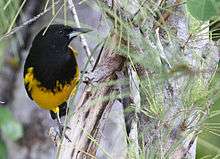Bahama oriole
| Bahama oriole | |
|---|---|
 | |
| Scientific classification | |
| Kingdom: | Animalia |
| Phylum: | Chordata |
| Class: | Aves |
| Order: | Passeriformes |
| Family: | Icteridae |
| Genus: | Icterus |
| Species: | I. northropi |
| Binomial name | |
| Icterus northropi (J. A. Allen, 1890) | |
The Bahama oriole (Icterus northropi) is a species of bird in the family Icteridae. It is endemic to the Bahamas. The taxon was originally classified as its own distinct species in 1890 by Joel Asaph Allen before it was lumped with the Cuban oriole (Icterus melanopsis), Hispaniolan oriole (Icterus dominicensis), and Puerto Rican oriole (Icterus portoricensis) into a single species by the ornithologist James Bond in his book "Birds of the West Indies" in 1960. It wasn't until 2010 that all four birds were elevated to full species status using mitochondrial DNA evidence.[2][3] As a result of it not being recognized as a distinct species for so long, the Bahama oriole's preferred non-breeding season habitat is unknown and current estimates of its exact numbers remain vague.
Historically, the Bahama oriole has been known only from two major islands in the Bahamas: Abaco and Andros. It became extirpated from Abaco in the 1990s, and today remains only on Andros in the Bahamas.[4] It can be found on the three major islands of Andros: North Andros, Mangrove Cay, and South Andros. It may also occur on some of the smaller cays, especially if palm trees are present, but current documentation is lacking. The species was recently recognized as Critically Endangered by Birdlife International,[5] with recent population estimates of 300 or fewer individuals remaining.[6][7]
The Bahama oriole's preferred habitats during the breeding season include coppice and human residential areas, the latter being especially important for nesting since the species prefers to nest in the tallest palm trees available, most often introduced coconut palm (Cocos nucifera).[8] Birds may also use the extensive Caribbean pine (Pinus caribaea) forest, but the importance of this habitat for the oriole remains unclear. Some nesting can occur in the pine forest when the understory grows sufficiently to support native palms. However, frequent fires, often set by humans, damage the understory. Though the general habitat of the Bahama oriole during the breeding season is known, the preferred habitat of the oriole during the non-breeding season is still unknown.[9]
The future of the Bahama oriole remains tenuous. The shiny cowbird (Molothrus bonariensis), a brood parasite that lays its eggs in the nests of other bird species, is naturally expanding its South American and West Indies range northward, and reached Andros in the mid-1990s.[10][11] Although still relatively uncommon, the cowbirds regularly parasitize the nests of orioles.[12][13] Also, many of the palms on North Andros, which the orioles preferentially select for nesting, are dying off because of lethal yellowing disease brought in with introduced palms.[14] The bigger threats, however, are continued habitat loss from human development and stochastic processes that, because of the oriole's small population size, increase the risk of extinction.
References
- ↑ BirdLife International (2013). "Icterus northropi". IUCN Red List of Threatened Species. Version 2013.2. International Union for Conservation of Nature. Retrieved 26 November 2013.
- ↑ Chesser, R. T., R. C. Banks, F. K. Barker, C. Cicero, J. L. Dunn, A. W. Kratter, I. J. Lovette, P. C. Rasmussen, J. V. Remsen, Jr, J. D. Rising , D. F. Stotz, and K. Winker. 2010. Fifty-first supplement to the American Ornithologists’ Union Check-list of North American Birds. Auk 127(3):726-744.
- ↑ Omland, Kevin; Cant, Shelley; Johnson, Scott; Jeffery, Matt; Tschirky, John; Robertson, Holly; Price, Melissa; Sillett, Scott (2015). "Conservation Biology of the Critically endangered Bahama Oriole: Status, Threats, and Reversing the Decline". Bahamas Natural History Conference.
- ↑ White, J. W. 1998. A birder’s guide to the Bahama Islands (including Turks and Caicos). American Birding Association, Inc., Colorado Springs, Colorado.
- ↑ http://www.birdlife.org/globally-threatened-bird-forums/wp-content/uploads/2011/02/Americas-2010-20112.xls
- ↑ Price, M. R. and W. K. Hayes. 2009. Conservation taxonomy of the Greater Antillean Oriole (Icterus dominicensis): diagnosable plumage variation among allopatric populations supports species status. Caribbean Ornithology 22:19-25.
- ↑ Price, M. R., V. Robinette, and W. K. Hayes. 2010. Population status and breeding ecology of the Bahama Oriole (Icterus dominicensis northropi). Pg. 75 in the COS/AOU/SCO Meeting Abstracts
- ↑ Price, M. R., V. Robinette, and W. K. Hayes. 2010. Population status and breeding ecology of the Bahama Oriole (Icterus dominicensis northropi). Pg. 75 in the COS/AOU/SCO Meeting Abstracts
- ↑ Omland, Kevin; Schulwitz, Sarah (2015). "Population Assessment of the Critically Endangered Bahama oriole: Status and Habitat usage During the Breeding and Non-Breeding Season". The Mohamed bin Zayed species Conservation Fund Application Form.
- ↑ Baltz, M. E. 1995. First records of Shiny cowbird (Molothrus bonariensis) in the Bahama Archipelago. Auk 112:1039-1041.
- ↑ Baltz. M. E. 1996. The distribution and status of the Shiny Cowbird on Andros Island. Bahamas Journal of Science 3(2):2-5.
- ↑ Baltz, M. E. 1997. Status of the Black-cowled Oriole (Icterus dominicensis northropi) in the Bahamas. Unpublished report to the Department of Agriculture, Nassau, Bahamas.
- ↑ Price, M. R., V. Robinette, and W. K. Hayes. 2010. Population status and breeding ecology of the Bahama Oriole (Icterus dominicensis northropi). Pg. 75 in the COS/AOU/SCO Meeting Abstracts
- ↑ Price, M. R., V. Robinette, and W. K. Hayes. 2010. Population status and breeding ecology of the Bahama Oriole (Icterus dominicensis northropi). Pg. 75 in the COS/AOU/SCO Meeting Abstracts
